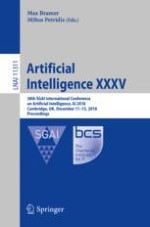This book constitutes the proceedings of the 38th SGAI International Conference on Innovative Techniques and Applications of Artificial Intelligence, AI 2018, held in Cambridge, UK, in December 2018.
The 25 full papers and 12 short papers presented in this volume were carefully reviewed and selected from 46 submissions. There are technical and application papers which were organized in topical sections named: Neural Networks; Planning and Scheduling; Machine Learning; Industrial Applications of Artificial Intelligence; Planning and Scheduling in Action; Machine Learning in Action; Applications of Machine Learning; and Applications of Agent Systems and Genetic Algorithms.
